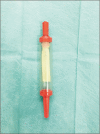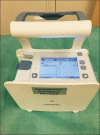Chest Tube Drainage of the Pleural Space: A Concise Review for Pulmonologists
- PMID: 29372629
- PMCID: PMC5874139
- DOI: 10.4046/trd.2017.0107
Chest Tube Drainage of the Pleural Space: A Concise Review for Pulmonologists
Abstract
Chest tube insertion is a common procedure usually done for the purpose of draining accumulated air or fluid in the pleural cavity. Small-bore chest tubes (≤14F) are generally recommended as the first-line therapy for spontaneous pneumothorax in non-ventilated patients and pleural effusions in general, with the possible exception of hemothoraces and malignant effusions (for which an immediate pleurodesis is planned). Large-bore chest drains may be useful for very large air leaks, as well as post-ineffective trial with small-bore drains. Chest tube insertion should be guided by imaging, either bedside ultrasonography or, less commonly, computed tomography. The so-called trocar technique must be avoided. Instead, blunt dissection (for tubes >24F) or the Seldinger technique should be used. All chest tubes are connected to a drainage system device: flutter valve, underwater seal, electronic systems or, for indwelling pleural catheters (IPC), vacuum bottles. The classic, three-bottle drainage system requires either (external) wall suction or gravity ("water seal") drainage (the former not being routinely recommended unless the latter is not effective). The optimal timing for tube removal is still a matter of controversy; however, the use of digital drainage systems facilitates informed and prudent decision-making in that area. A drain-clamping test before tube withdrawal is generally not advocated. Pain, drain blockage and accidental dislodgment are common complications of small-bore drains; the most dreaded complications include organ injury, hemothorax, infections, and re-expansion pulmonary edema. IPC represent a first-line palliative therapy of malignant pleural effusions in many centers. The optimal frequency of drainage, for IPC, has not been formally agreed upon or otherwise officially established.
Keywords: Catheters; Chest Tubes; Drainage; Pleura; Pleural Effusion; Pneumothorax.
Copyright©2018. The Korean Academy of Tuberculosis and Respiratory Diseases.
Conflict of interest statement
No potential conflict of interest relevant to this article was reported.
Figures






References
-
- Mullon JJ, Burkart KM, Silvestri G, Hogarth DK, Almeida F, Berkowitz D, et al. Interventional pulmonology fellowship accreditation standards: executive summary of the Multisociety Interventional Pulmonology Fellowship Accreditation Committee. Chest. 2017;151:1114–1121. - PubMed
-
- Colt H. Drainage techniques. In: Light RW, Gary Lee YC, editors. Textbook of pleural diseases. 3rd ed. Boca Raton: CRC Press; 2016. pp. 534–552.
-
- Colt HG, Mathur PN. Manual of pleural procedures. Philadelphia: Lippincott Williams & Wilkins; 1999.
-
- Kiefer T. Chest drains in clinical practice. Cham: Springer; 2017.
Publication types
LinkOut - more resources
Full Text Sources
Other Literature Sources

